A Comprehensive Evaluation Model for Optimizing the Sensor Array of Electronic Nose
Abstract
:1. Introduction
2. Theory and Methodology
2.1. Selection of Sensor Evaluation Indicators
2.1.1. Sensitivity
2.1.2. Selectivity
2.1.3. Correlation
2.1.4. Repeatability
2.2. Assignment of the Weight Value for Indicators
- −
- Calculate the weight value of each sensor of the jth evaluation indicator:
- −
- Calculate the entropy value of the jth evaluation indicator:
- −
- Obtain the total entropy weight of jth evaluation indicator:
2.3. Construction of the Comprehensive Evaluation Model
3. Validation of the Evaluation Model
3.1. Initial Gas Sensor Array
3.2. Experimental Procedures
- −
- Preheat the sensor array for 30 min, and flush the sensor array chamber with ambient air (300 mL/min) until the sensor baseline stabilizes.
- −
- Pump the target gas into the senser array chamber, the gas pumping time was 5 s and the response time was 120 s, and collect the response signal data of the sensor to the target gas during this whole process.
- −
- Purge the sensor array chamber with ambient air until all sensors return to their original baseline, then start the detection for the next gas sample.
4. Results
4.1. Response of the Initial Sensor Array to the Detected Gases
4.2. Analysis of Single Evaluation Indicator
4.2.1. Results of Sensitivity Indicator
4.2.2. Results of Selectivity Indicator
4.2.3. Results of Correlation Indicator
4.2.4. Results of Repeatability Indicator
4.3. Weight Values of Evaluation Indicators
4.4. Comprehensive Evaluation Results Based on the EWM-TOPSIS Model
5. Discussion
5.1. Effect of Sensor Array Optimization on Extracted Gas Features
5.2. Effect of Sensor Array Optimization on Recognition Accuracy of E-nose
6. Conclusions
- (1)
- The optimization of the sensor array for E-nose according to a single evaluation indicator has limitations.
- (2)
- Different evaluation indicators contribute differently to the overall performance of the E-nose. Therefore, the weights of different evaluation indicators should be considered when comprehensively evaluating the sensor array.
- (3)
- The proposed comprehensive evaluation model based on EWM-TOPSIS can accurately reflect the contribution of different evaluation indicators to the overall performance of the sensor array, and the recognition accuracy of the E-nose with the sensor array optimized by this model can be significantly improved.
Author Contributions
Funding
Institutional Review Board Statement
Informed Consent Statement
Data Availability Statement
Conflicts of Interest
References
- Ahmadipour, M.; Pang, A.L.; Ardani, M.R.; Pung, S.-Y.; Ooi, P.C.; Hamzah, A.A.; Wee, M.M.R.; Haniff, M.A.S.M.; Dee, C.F.; Mahmoudi, E.; et al. Detection of breath acetone by semiconductor metal oxide nanostructures-based gas sensors: A review. Mater. Sci. Semicond. Process. 2022, 149, 106897. [Google Scholar] [CrossRef]
- Cociorva, S.; Iftene, A. Indoor Air Quality Evaluation in Intelligent Building. Energy Procedia 2017, 112, 261–268. [Google Scholar] [CrossRef]
- Wen, J.; Zhao, Y.; Rong, Q.; Yang, Z.; Yin, J.; Peng, Z. Rapid odor recognition based on reliefF algorithm using electronic nose and its application in fruit identification and classification. J. Food Meas. Charact. 2022, 16, 2422–2433. [Google Scholar] [CrossRef]
- Wasilewski, T.; Gębicki, J. Emerging strategies for enhancing detection of explosives by artificial olfaction. Microchem. J. 2021, 164, 106025. [Google Scholar] [CrossRef]
- Feng, S.; Farha, F.; Li, Q.; Wan, Y.; Xu, Y.; Zhang, T.; Ning, H. Review on Smart Gas Sensing Technology. Sensors 2019, 19, 3760. [Google Scholar] [CrossRef]
- Bag, A.K.; Tudu, B.; Bhattacharyya, N.; Bandyopadhyay, R. Dealing with Redundant Features and Inconsistent Training Data in Electronic Nose: A Rough Set Based Approach. IEEE Sens. J. 2014, 14, 758–767. [Google Scholar] [CrossRef]
- Cheng, L.; Meng, Q.-H.; Lilienthal, A.J.; Qi, P.-F. Development of compact electronic noses: A review. Meas. Sci. Technol. 2021, 32, 062002. [Google Scholar] [CrossRef]
- Alizadeh, T. Chemiresistor sensors array optimization by using the method of coupled statistical techniques and its application as an electronic nose for some organic vapors recognition. Sens. Actuators B Chem. 2010, 143, 740–749. [Google Scholar] [CrossRef]
- Yin, Y.; Yu, H.; Chu, B.; Xiao, Y. A sensor array optimization method of electronic nose based on elimination transform of Wilks statistic for discrimination of three kinds of vinegars. J. Food Eng. 2014, 127, 43–48. [Google Scholar] [CrossRef]
- Xu, Z.; Shi, X.; Lu, S. Integrated sensor array optimization with statistical evaluation. Sens. Actuators B Chem. 2010, 149, 239–244. [Google Scholar] [CrossRef]
- Leccese, F.; Cagnetti, M.; Giarnetti, S.; Petritoli, E.; Tuti, S.; Luisetto, I.; Pecora, A.; Maiolo, L.; Durovic-Pejcev, R.; Dordevic, T.; et al. Electronic Nose: A First Sensors Array Optimization for Pesticides Detection Based on Wilks’ A-Statistic. In Proceedings of the 2018 5th IEEE International Workshop on Metrology for AeroSpace (MetroAeroSpace), Rome, Italy, 20–22 June 2018. [Google Scholar]
- Chen, R.R.; Luo, D.H.; Sun, Y.; Sun, Y.L.; Hossini, H.G. A Sensor Array Optimization Method Based on Variance Difference for Machine Olfaction. Appl. Mech. Mater. 2014, 618, 523–527. [Google Scholar] [CrossRef]
- Borowik, P.; Adamowicz, L.; Tarakowski, R.; Siwek, K.; Grzywacz, T. Odor Detection Using an E-Nose with a Reduced Sensor Array. Sensors 2020, 20, 3542. [Google Scholar] [CrossRef]
- Chaudry, A.N.; Hawkins, T.; Travers, P. A method for selecting an optimum sensor array. Sens. Actuators B Chem. 2000, 69, 236–242. [Google Scholar] [CrossRef]
- Russo, R.D.F.S.M.; Camanho, R. Criteria in AHP: A Systematic Review of Literature. Procedia Comput. Sci. 2015, 55, 1123–1132. [Google Scholar] [CrossRef]
- Zhu, Y.; Tian, D.; Yan, F. Effectiveness of Entropy Weight Method in Decision-Making. Math. Probl. Eng. 2020, 2020, 3564835. [Google Scholar] [CrossRef]
- Yu, L.; Yang, W.; Duan, Y.; Long, X. A Study on the Application of Coordinated TOPSIS in Evaluation of Robotics Academic Journals. Math. Probl. Eng. 2018, 2018, 5456064. [Google Scholar] [CrossRef]
- Zhao, C.; Zhao, Y. The investigation of Zn content on the structure and electrical properties of ZnxCu0.2Ni0.66Mn2.14−xO4 negative temperature coefficient ceramics. J. Mater. Sci. Mater. Electron. 2012, 23, 1788–1792. [Google Scholar] [CrossRef]
- Tong, Y.; Zhao, B.; Zhao, Y.; Yang, T.; Yang, F.; Hu, Q.; Zhao, C. Novel Anode-Supported Tubular Solid-Oxide Electrolytic Cell for Direct NO Decomposition in N2 Environment. Int. J. Electrochem. Sci. 2015, 10, 5338–5349. [Google Scholar]
- Zhao, Y.; Zhao, C.; Huang, J.; Zhao, B. LaMnO3–Ni0.75Mn2.25O4 Supported Bilayer NTC Thermistors. J. Am. Ceram. Soc. 2014, 97, 1016–1019. [Google Scholar] [CrossRef]
- Zhao, Y.; Zhao, C.; Tong, Y. Spinel-structured Ni-free Zn0.9CuxMn2.1−xO4 (0.1 ≤ x ≤ 0.5) thermistors of negative temperature coefficient. J. Electroceramics 2013, 31, 286–290. [Google Scholar] [CrossRef]
- Kumar, R.; Singh, S.; Bilga, P.S.; Jatin; Singh, J.; Singh, S.; Scutaru, M.-L.; Pruncu, C.I. Revealing the benefits of entropy weights method for multi-objective optimization in machining operations: A critical review. J. Mater. Res. Technol. 2021, 10, 1471–1492. [Google Scholar] [CrossRef]
- Salih, M.M.; Zaidan, B.; Zaidan, A.; Ahmed, M.A. Survey on fuzzy TOPSIS state-of-the-art between 2007 and 2017. Comput. Oper. Res. 2019, 104, 207–227. [Google Scholar] [CrossRef]


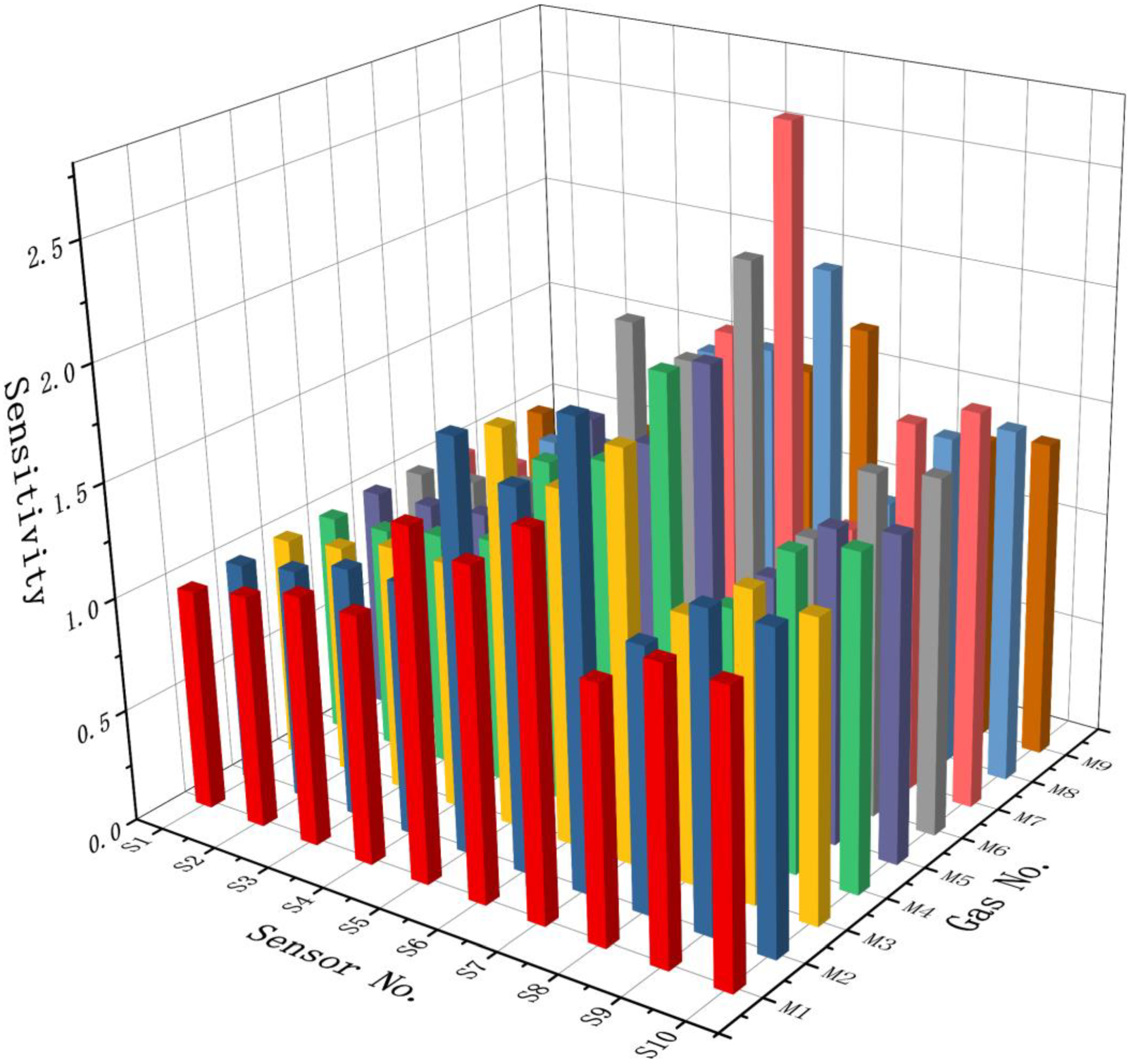

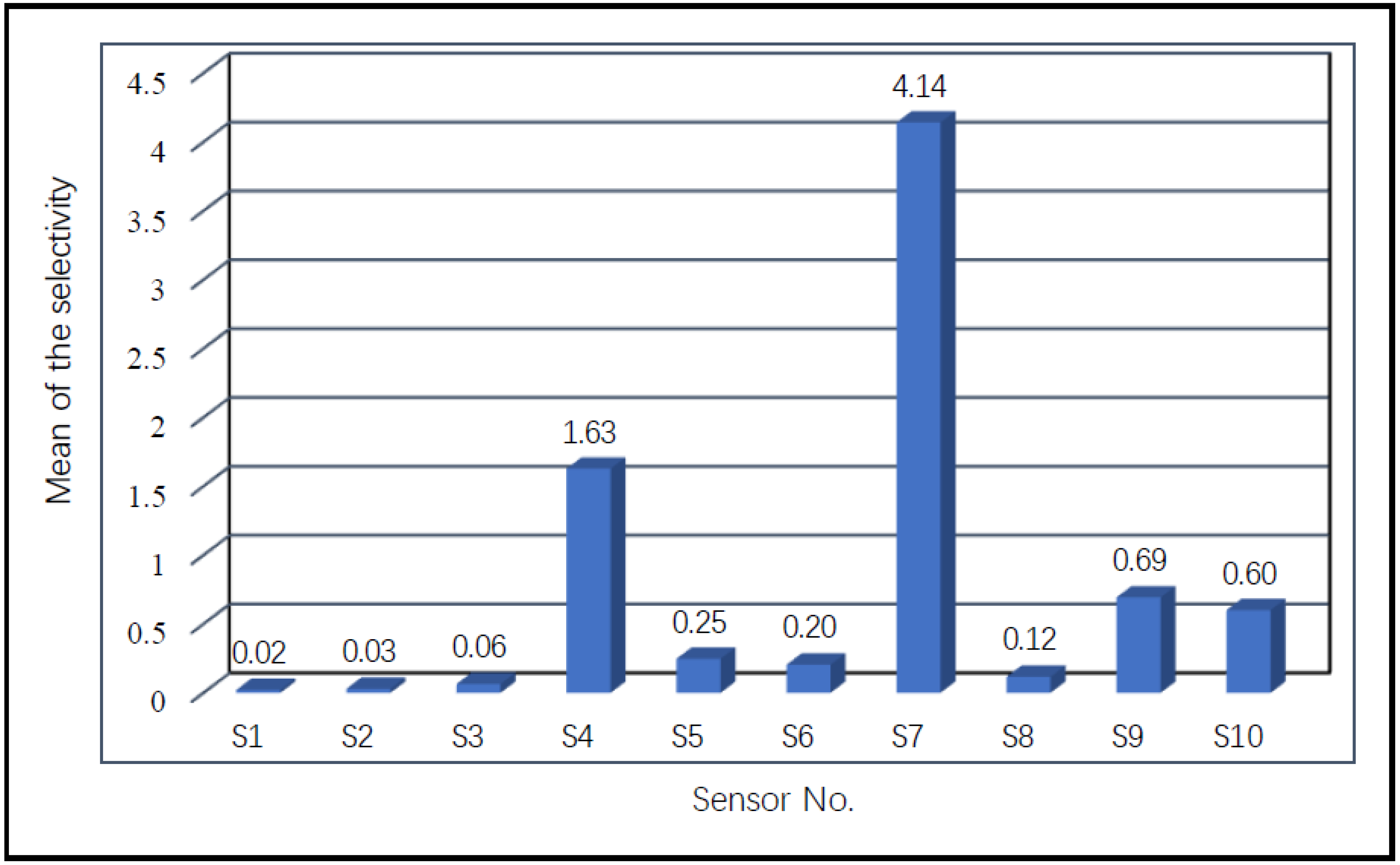

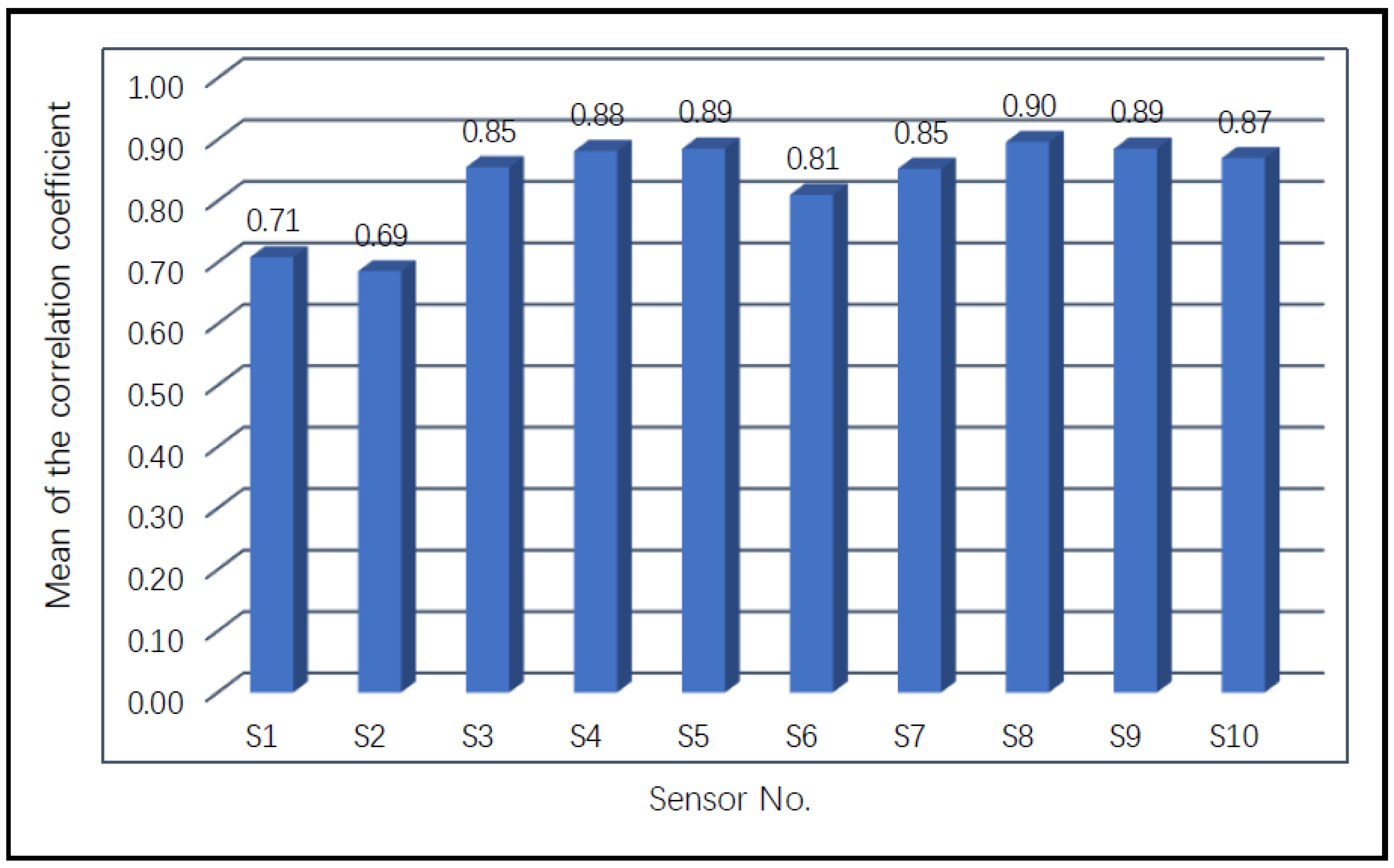
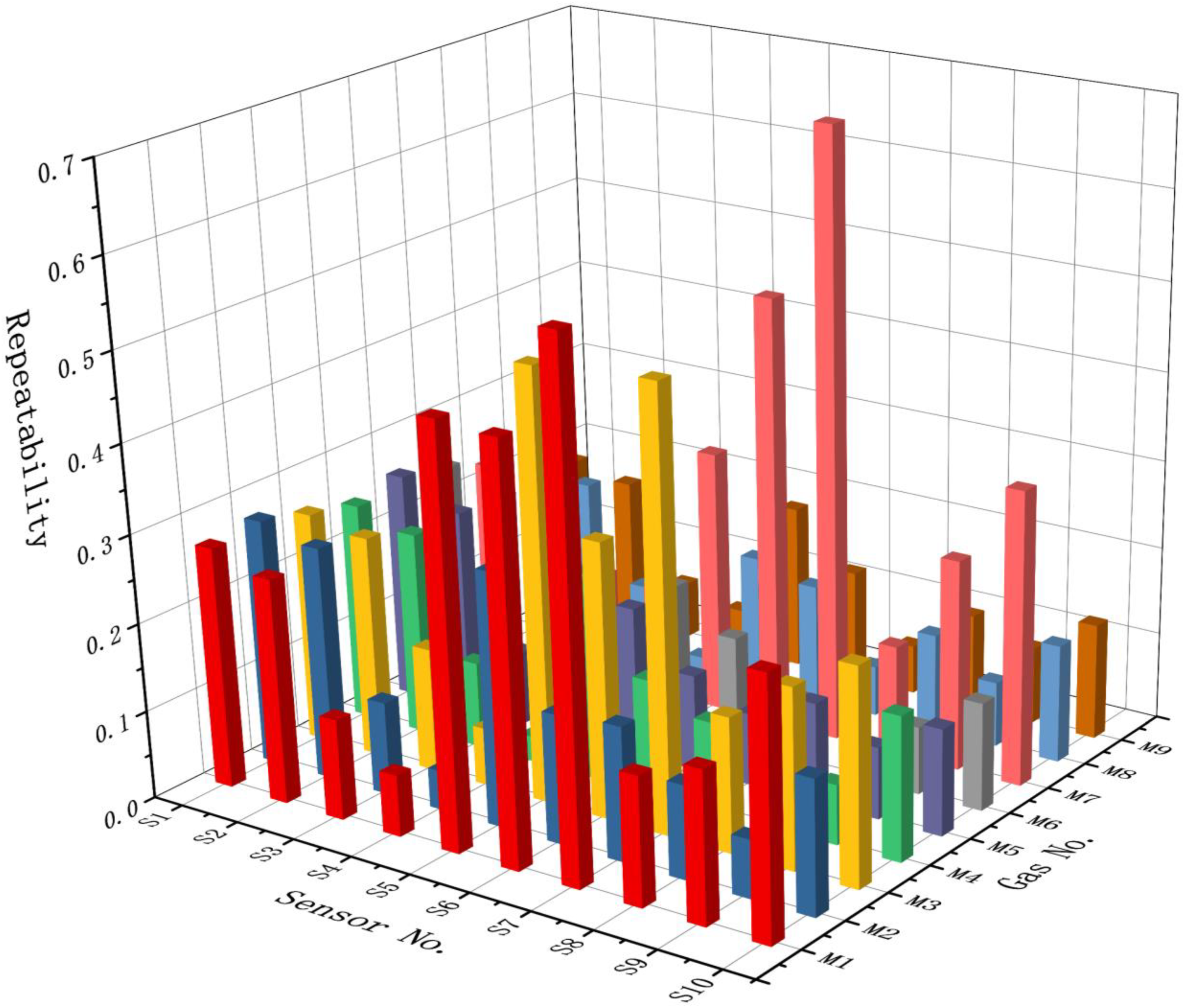
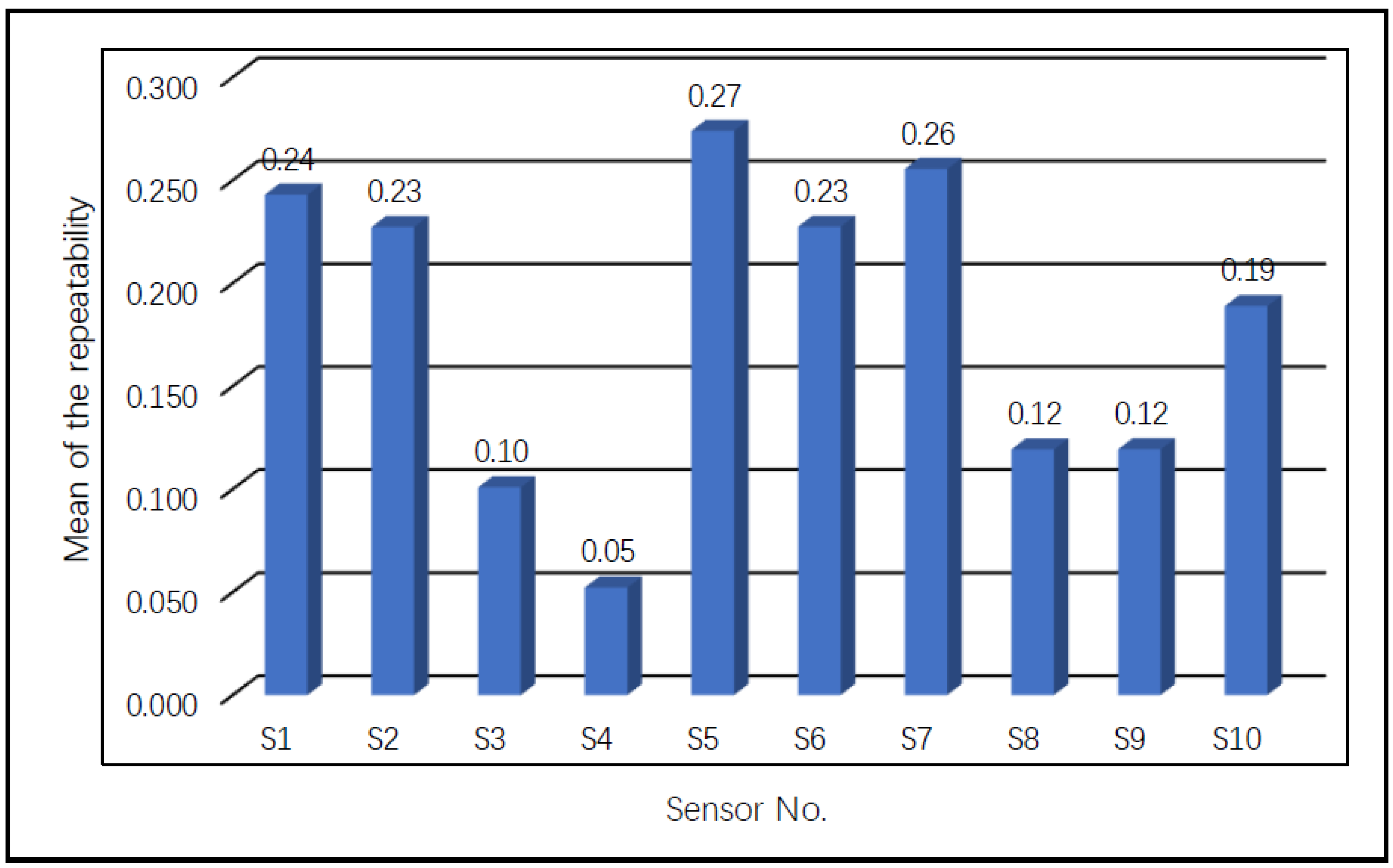


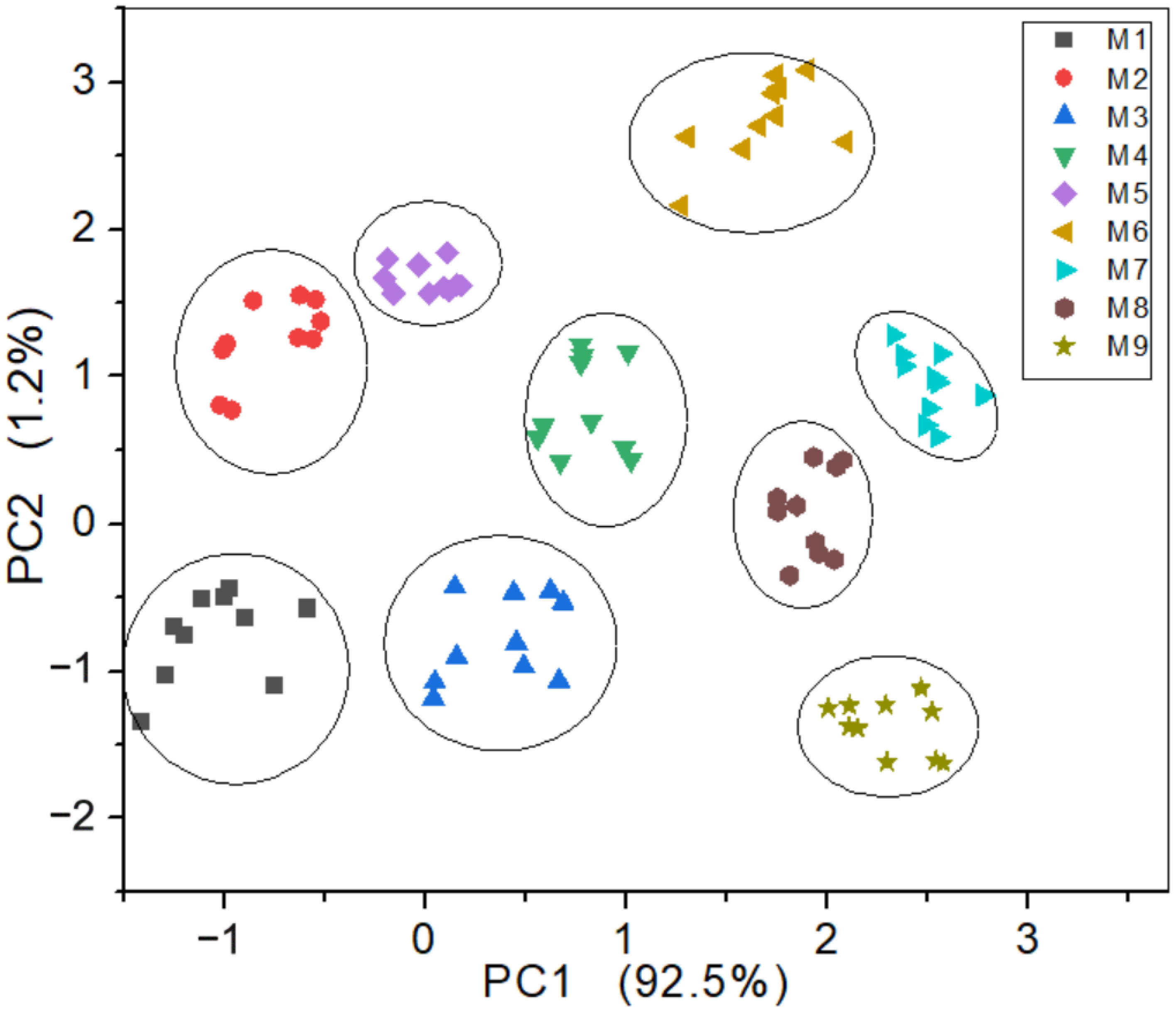
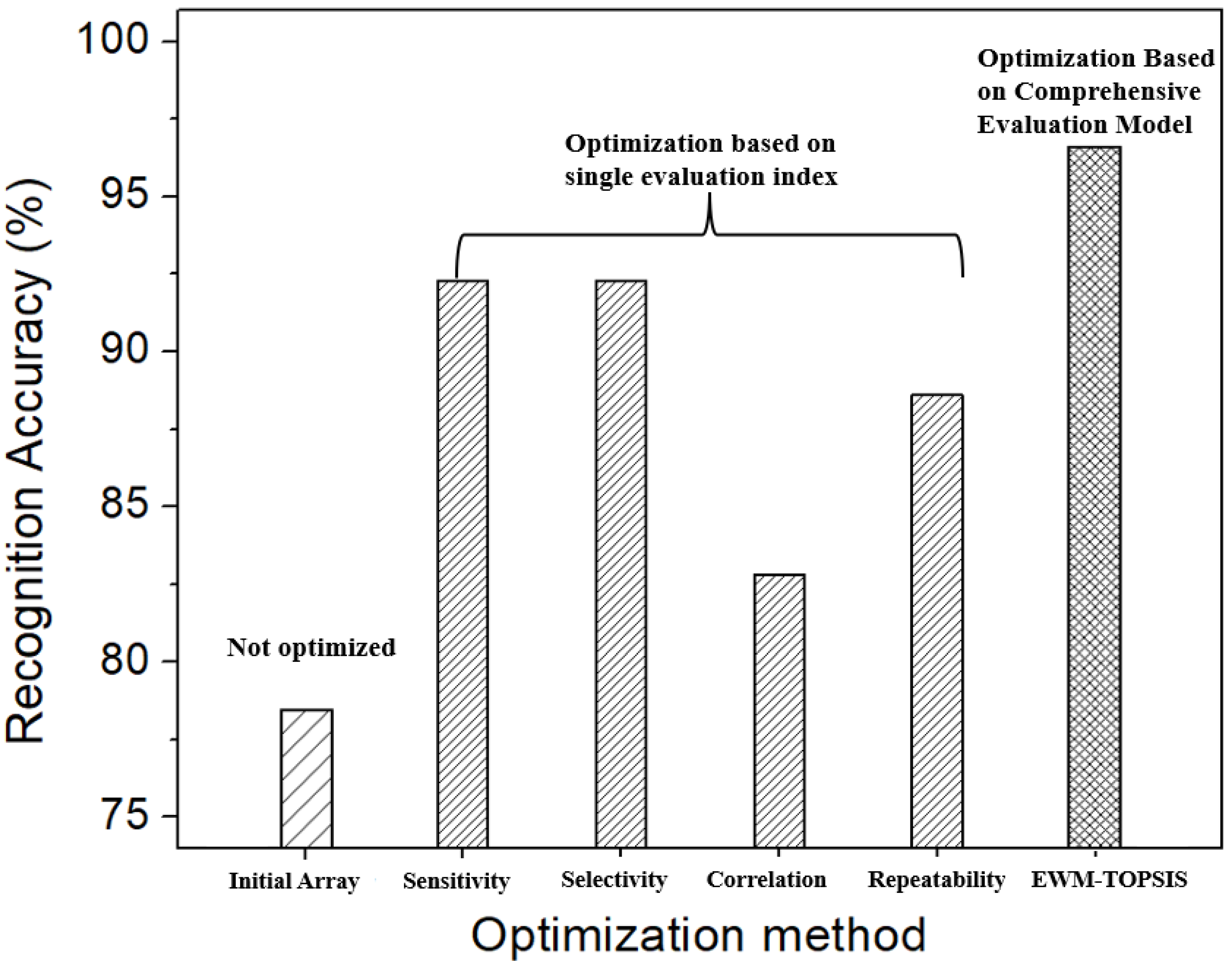
| Sensor No. | Main Detected Gas | Response Time | Recovery Time |
|---|---|---|---|
| S1 | Benzenes, VOCs | <10 s | <60 s |
| S2 | Air quality control, nitrogen oxides | <5 s | <30 s |
| S3 | VOCs, ethanol, acetone | <10 s | <60 s |
| S4 | Ethanol, methane, VOCs | <5 s | <30 s |
| S5 | Hydrogen, hydrogen sulfide, methane, | <10 s | <60 s |
| S6 | Formaldehyde, carbon monoxide, methane | <5 s | <20 s |
| S7 | Carbon monoxide, ethanol, methane, | <5 s | <30 s |
| S8 | Ethanol, ammonia | <10 s | <30 s |
| S9 | Acetone, hydrogen sulfide, ethanol | <5 s | <30 s |
| S10 | Hydrogen sulfide, ethanol, carbon monoxide | <10 s | <60 s |
| Gas No. | CO (ppm) | CH4 (ppm) |
|---|---|---|
| M1 | 10 | 1000 |
| M2 | 10 | 2000 |
| M3 | 10 | 3000 |
| M4 | 20 | 1000 |
| M5 | 20 | 2000 |
| M6 | 20 | 3000 |
| M7 | 30 | 1000 |
| M8 | 30 | 2000 |
| M9 | 30 | 3000 |
| Evaluation Indicator | Sensors Retained after Optimization | Sensors Recommended for Removal |
|---|---|---|
| Sensitivity | S4, S5, S6, S7, S8, S9, S10 | S1, S2, S3 |
| Selectivity | S4, S5, S6, S7, S8, S9, S10 | S1, S2, S3 |
| Correlation | S1, S2, S3, S5, S6, S7, S8 | S5, S8, S9 |
| Repeatability | S4, S5, S6, S7, S8, S9, S10 | S3, S4, S8 |
| Evaluation Indicator | Weight Values |
|---|---|
| Sensitivity | 0.357 |
| Selectivity | 0.452 |
| Correlation | 0.015 |
| Repeatability | 0.176 |
| Sensor No. | Score | Ranking |
|---|---|---|
| S1 | 0.005 | 10 |
| S2 | 0.008 | 9 |
| S3 | 0.054 | 5 |
| S4 | 0.236 | 2 |
| S5 | 0.032 | 7 |
| S6 | 0.028 | 8 |
| S7 | 0.423 | 1 |
| S8 | 0.044 | 6 |
| S9 | 0.096 | 3 |
| S10 | 0.076 | 4 |
Disclaimer/Publisher’s Note: The statements, opinions and data contained in all publications are solely those of the individual author(s) and contributor(s) and not of MDPI and/or the editor(s). MDPI and/or the editor(s) disclaim responsibility for any injury to people or property resulting from any ideas, methods, instructions or products referred to in the content. |
© 2023 by the authors. Licensee MDPI, Basel, Switzerland. This article is an open access article distributed under the terms and conditions of the Creative Commons Attribution (CC BY) license (https://creativecommons.org/licenses/by/4.0/).
Share and Cite
Peng, Z.; Zhao, Y.; Yin, J.; Peng, P.; Ba, F.; Liu, X.; Guo, Y.; Rong, Q.; Zhang, Y. A Comprehensive Evaluation Model for Optimizing the Sensor Array of Electronic Nose. Appl. Sci. 2023, 13, 2338. https://doi.org/10.3390/app13042338
Peng Z, Zhao Y, Yin J, Peng P, Ba F, Liu X, Guo Y, Rong Q, Zhang Y. A Comprehensive Evaluation Model for Optimizing the Sensor Array of Electronic Nose. Applied Sciences. 2023; 13(4):2338. https://doi.org/10.3390/app13042338
Chicago/Turabian StylePeng, Zhi, Yongli Zhao, Jianxin Yin, Peng Peng, Fushuai Ba, Xiaolong Liu, Youmin Guo, Qian Rong, and Yafei Zhang. 2023. "A Comprehensive Evaluation Model for Optimizing the Sensor Array of Electronic Nose" Applied Sciences 13, no. 4: 2338. https://doi.org/10.3390/app13042338
APA StylePeng, Z., Zhao, Y., Yin, J., Peng, P., Ba, F., Liu, X., Guo, Y., Rong, Q., & Zhang, Y. (2023). A Comprehensive Evaluation Model for Optimizing the Sensor Array of Electronic Nose. Applied Sciences, 13(4), 2338. https://doi.org/10.3390/app13042338






